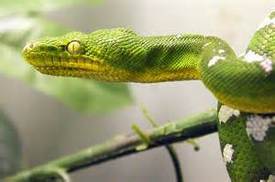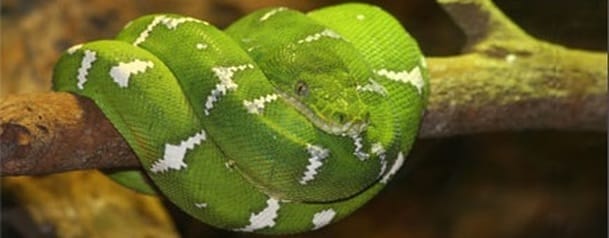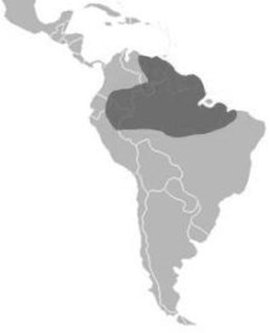Emerald Tree BoaCorallus caninus |

Custom Search
|
They live in tropical rain forests and wetlands. The emerald tree boa is often found alongside rivers but isn't dependent on open water. The areas in which they live receive usually more than 1500 mm of annual rain, and range from sea level up to 3300 ft (1000) m in altitude.
The Emerald tree boa snake can reach about 79 inches or 2 meters in length. The head is large and somewhat flat, the body is laterally flattened and somewhat triangular in shape, and the tail is prehensile. Female emerald tree boas are usually larger in size, but males have larger spurs. The dorsal skin is emerald green, (therefore its common name) in color with a white triangular patch pattern of regular distribution. In the ventral region, the skin is yellowish or whitish. The juvenile snakes have some varying color but are usually red-brown, orange or yellow, only gaining the characteristic and beautiful emerald green adult coloration at about 4 to 6 months of age. They have vertical pupils like those of cats. With proper care, the Emerald tree boa can reach well over 20 years when in captivity, but on average they tend to live for about 15 years in the wild. The emerald tree boa is preyed upon by birds of prey. The Guinean crested eagles (Morphnus guianensis) is the only known predator of the emerald tree boa.

Being non-venomous snakes these snakes kill their prey by constriction, holding them with their mandibles and wrapping the body around them, immobilizing and squeezing the prey until it dies from asphyxiation.
The Emerald Tree Boa has for the most part arboreal habits and rarely comes down to the ground level. Their cryptic coloration and pattern help them remain hidden among the foliage of the trees. They are capable of moving very fast through the foliage and tree tops. When resting, they will cling firmly to a tree branch with the tail and wrap the rest of the body around it.This behavior is similar to that of the green tree python. The emerald tree boa is a solitary species that interacts only when mating, but on occasion aggressive behavior between males can occur if they get too close to one another. They have pits located around their mouth used for detecting their prey using the heat it gives off. They have much more of these heat sensors located around its mouth when compared to other boas like the boa constrictor. But just like other snakes, they can also use their forked tongues and Jacobson's organ to sense chemical cues and they can also detect vibrations. They are also known by other common names like green tree boa and emerald Boa. Diet / Feeding
The emerald tree boa is a nocturnal ambush predator. These snakes feed mainly on lizards and birds, but also of small arboreal mammals. The offspring of the Emerald tree boa snake can hunt and eat almost immediately after birth. The juvenile snakes will sometimes feed on small reptiles and amphibians. Reproduction Actually very little is known about the emerald tree boa reproductive behavior. We know that this is an ovoviviparous snake species, the eggs are kept inside the female's body during their embryonic development. The breeding season occurs between April and July coinciding with late winter and early spring in the tropical regions they inhabit. The female snake manages to raise its temperature and incubate the eggs, making her body tremble and shiver. The average clutch can range from 3 to 18 juveniles that are born after about 7 months of embryonic development, usually between the months of July and December. The hatchlings are around 16 to 20 inches (40 to 50 cm) long at birth and weigh 20 to 50 g. It's only at about 4 months old, the young snakes begin to develop their adult, beautiful green coloration. The females only reproduce every two years. Males reach sexual maturity at three or four years of age and the female at four or five years. Sometimes this species interbreeds with other member of the Corallus family, the Amazon tree boa (Corallus hortulanus) producing very colorful offspring. Conservation / Threats This species is not considered to be globally threatened, according to the International Union for Conservation of Nature. It is included in Appendix II of CITES and export quotas are in effect in some countries. Habitat destruction is the main threat to be taken into account for the future survival of the species. They are also widely collected from the wild for the exotic pet trade, being very popular and sold for high prices.
|
Did You Know?
A group of snakes is called a bed, den, pit or nest, find more facts about snakes for kids. Scientific classification |
© 2014 Snake Facts About Us | Privacy Policy | Contact




